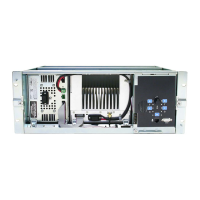44 Reciter Circuit Description TB8100 Service Manual
© Tait Electronics Limited September 2006
The VCO feedback attenuator is a resistive divider that terminates the VCO
feedback signal in a fixed low impedance (50Ω). This attenuates the VCO
RF level down to a level suitable for the RF prescaler (within the synthesizer
IC).
A 12.8MHz temperature controlled crystal oscillator (TCXO) is used as the
internal reference oscillator. When the TCXO is active, the receiver
synthesizer is locked to an “internal reference mode” (by default).
Alternatively, a phase-locked 12.8MHz voltage controlled crystal oscillator
(VCXO) can be used as the external reference oscillator. When the VCXO
is active, the receiver synthesizer is locked to an “external reference mode”.
In operation only one oscillator is active at any given time. Refer to
“Reference Switch” on page 35 for details on the phase-locked 12.8MHz
external reference oscillator.
The reference oscillators are buffered, branched, and divided down to the
6.25kHz (default) or 5kHz divider reference within the synthesizer IC. The
same divider reference is maintained by dividing the VCO feedback signal
using the prescaler and programmable dividers of the synthesizer IC. Phase
lock is achieved when both divider references have the same phase and
frequency content (i.e. their difference is zero or DC). This is achieved by
the phase detector (part of the synthesizer IC), which compares both divider
references and delivers an error signal. A ±4mA charge pump circuit (also
part of the synthesizer IC) and the active loop filter circuit convert this error
signal to a DC voltage (0 to 22V
1
) to tune the VCO for correction. The
loop filter has a bandwidth of 150Hz and filters the VCO control lines,
reference side bands and spurious signals.
Note The VCO frequency increases as the control line voltage increases.
2.4.5 VCO
The receiver VCO consists of a high Q VCO, low noise amplifier, harmonic
filter, fixed slope attenuator, and a final driver. Refer to Figure 2.8 on
page 45.
High Q VCO The VCO BJT transistor operates in a common collector, Colpitts oscillator
configuration, and uses a shorted quarter-wave ceramic coaxial resonator.
The open end of the resonator is terminated by a combination of a high Q
trimmer and varactor diodes. This forms a high Q resonator which is both
mechanically and electronically tunable. Mechanical tuning is possible by
adjusting the trimmer. Changes in the control voltage from the loop filter
are applied to the varactors to facilitate electronic tuning.
Low Noise Amplifier An N-channel dual gate MOSFET is used as a broad band matched Class A
low noise amplifier. It has internal self-bias circuitry, and the output
provides enough RF power to drive the following stages.
1. The normal lock range is between 3V and 16V.

